What Is A Deductible? How To Calculate Your Deductible
Most health insurance plans come with a deductible, which is the amount you have to pay for medical services before your insurance company starts to pay. The deductible may be a fixed dollar amount, such as $500, or it may be a percentage of your overall medical costs. For example, your plan might have a $500 deductible and then pay 80% of your covered medical expenses after that.
You would be responsible for the other 20%.
How does a health insurance Deductible work?
Most health insurance plans come with a deductible, which is the amount you have to pay for medical expenses before your insurance company starts to chip in. For example, if your deductible is $1,000 and you have a $500 medical bill, you’ll only be responsible for paying $500 – your insurance will cover the rest.
Deductibles can vary widely from one plan to the next, so it’s important to understand how yours works before you need to use it.
Some plans also have separate deductibles for different types of care, like prescriptions or mental health services.
At first glance, a high deductible might not seem ideal – but it can actually save you money in the long run. Plans with high deductibles tend to have lower monthly premiums, so they can be a good option for people who are healthy and don’t expect to need much medical care.
Of course, no one likes unexpected medical bills. If you’re worried about being able to afford your deductible, look into Health Savings Accounts (HSAs) or Flexible Spending Accounts (FSAs). These accounts let you set aside pre-tax money that can be used to cover qualifying medical expenses – including your deductible.
What is a Good Deductible for Health Insurance
When you are looking for a health insurance plan, one of the things you will want to consider is the deductible. The deductible is the amount of money that you will need to pay out-of-pocket before your insurance company starts to pay for your medical expenses.
There is no one answer to the question of how much should your deductible be.
It depends on a number of factors, including your personal financial situation and your health needs. Some people prefer to have a lower deductible so that they don’t have to pay as much out-of-pocket if they need to use their health insurance. Others prefer a higher deductible so that they can save on their monthly premiums.
Ultimately, you will need to decide what trade-off between monthly premium and out-of-pocket costs makes sense for you. If you are healthy and don’t anticipate needing much in the way of medical care, then a high deductible plan might be a good option for you. On the other hand, if you have chronic health conditions or anticipate needing lots of medical care, then a low deductible plan might be better for you.
No matter what kind of plan you choose, make sure that you understand all of the terms and conditions before enrolling. This way, you can be sure that you are getting the coverage that you need at a price that makes sense for your budget.
What is Coinsurance
What is Coinsurance?
Coinsurance is a type of health insurance in which the policyholder is responsible for paying a portion of their medical bills, while the insurer covers the rest. The policyholder’s coinsurance responsibility is typically a percentage of the total bill, and it usually applies after the deductible has been met.
For example, if you have a 20% coinsurance and your doctor visit costs $100, you would be responsible for $20 while your insurer would cover the remaining $80.
While having to pay a portion of your medical bills can seem like an inconvenience, coinsurance actually helps to keep premiums lower than if you had to pay 100% of all your medical expenses out-of-pocket. In addition, most plans have an out-of-pocket maximum that limits how much you would have to spend on covered healthcare services in a given year.
Once you reach this maximum, your coinsurance payments would stop and the insurer would cover 100% of any remaining eligible expenses.
If you’re shopping for health insurance or trying to understand your current coverage, it’s important to know what kinds of expenses are typically subject to coinsurance. These can include things like hospitalization, surgery, diagnostic tests, prescriptions, and more.
Be sure to check with your insurer or read through your policy documents so that you know exactly what types of charges will require you to paycoinsurance.
What is Coinsurance in Health Insurance
What is Coinsurance in Health Insurance?
In basic terms, coinsurance is the sharing of responsibility for payment of medical expenses between the patient and the health insurance company. The patient pays a fixed percentage of the bill (for example, 20%), while the insurance company pays the rest.
In some cases, there may be a deductible that must be met before any coinsurance payments are required.
There are several reasons why an insurer might require their policyholders to share in the cost of their healthcare. One reason is that it helps to keep premiums lower by spreading out the cost among many people.
Another reason is that it gives patients an incentive to be more selective about which services they use, since they will be paying a portion of the costs themselves.
Coinsurance can be a confusing concept for patients, who may not know how much their portion of a medical bill will be until after they receive care. It’s important to understand how your particular policy works so that you can budget for your share of costs.
If you have questions about your coverage, don’t hesitate to contact your insurance company or agent for clarification.
What is a Deductible in Insurance
A deductible is an amount that you, the policyholder, are responsible for paying out-of-pocket before your insurance company pays on a covered claim. In other words, if you have a $1,000 deductible and you file a $2,000 claim with your insurer, you will pay the first $1,000 of that claim and your insurer will pay the remaining $1,000. Deductibles are one way that insurance companies keep premiums low – by making policyholders share in some of the initial costs of a covered incident.
But they also protect insurers from having to cover small claims that could be easily paid out by the policyholder. There are two types of deductibles: per occurrence and per year. A per occurrence deductible applies to each separate event or incident (e.g., if you have two car accidents in one year, each would require its owndeductible to be paid).
A per year deductible is a set amount that you must pay every year regardless of how many times you use your insurance (e.g., if your yearly deductible is $500 and you have three different incidents during the year where you need to use your insurance coverage, you would still only pay $500 total for the year). Some policies also have what’s called a “no fault” or “first dollar” deductible . This type of deductible doesn’t apply until after the insurance company has already paid out a certain amount – usually around $1,000 – on behalf of the policyholder.
So if you had a $500 no fault deductible and filed a $2,000 claim with your insurer , they would first pay out $1 , 000 (up to their limit) and then YOU would be responsible for paying the next $500 . Deductibles can range widely in terms of how much money policyholders are required to pay. It’s not uncommon for deductibles to start at around$100 but some high-end policies can have deductibles upwards of$5 , 000 .
Read more: The Definitive Guide On How To Get Rid Of Private Investigators
Deductible Vs Copay
When you have health insurance, you typically have to pay two types of costs: deductibles and copays. A deductible is the amount of money you have to spend out-of-pocket before your insurance kicks in and starts covering costs. A copay is a fixed amount that you pay for a particular service, like a doctor’s visit or prescription medication.
Deductibles can vary widely from one health insurance plan to another. They may be as low as $50 or $100, or they could be several thousand dollars. The higher your deductible, the lower your monthly premiums will be.
But that means you’ll have to pay more out-of-pocket costs if you need medical care.
Copays also vary depending on the type of service being provided and the health insurance plan you have. Doctor’s visits may have a $20-$30 copay, while emergency room visits may have a much higher copay or none at all.
Prescription drugs usually come with a copay as well, though some plans require you to pay a percentage of the cost (coinsurance).
Deductible Vs Premium
When it comes to your health insurance, there are two key terms that you need to know – deductible and premium. Your premium is the amount that you pay each month for your health insurance coverage. Your deductible is the amount that you must pay out-of-pocket before your insurance company will start to pay for covered services.
While your monthly premium is important, it’s usually the deductible that has the biggest impact on your wallet. A high deductible plan can help you save on premiums, but it means that you’ll have to pay more out-of-pocket when you need care. A low deductible plan will cost you more each month, but can help keep costs down when you actually need to use your insurance.
The best way to decide which type of plan is right for you is to think about how often you expect to use your health insurance and how much you’re willing to pay out-of-pocket when you do need care. If you only ever go to the doctor for an annual checkup and don’t take any medications, a high deductible plan might be a good option for you. But if you have a chronic condition or take regular medication, a low deductible plan could end up saving you money in the long run.
Do You Have to Pay Health Insurance Deductible Upfront
If you have health insurance, you may be wondering if you have to pay your deductible upfront. The answer is that it depends on your particular plan. Some plans require that you pay the deductible before they will start paying for any medical expenses.
Other plans allow you to make payments toward the deductible over time. Still other plans may not have a deductible at all.
If your plan requires that you pay the deductible upfront, then you will need to budget for this expense when planning your healthcare costs for the year.
Keep in mind that the amount of the deductible may change from year to year, so be sure to check with your insurer each year to find out how much money you will need to set aside.
If your plan allows you to make payments toward the deductible over time, then you can spread out this cost throughout the year and not have to worry about coming up with a large sum of money all at once. This can make budgeting for healthcare costs a bit easier.
Some plans do not have adeductibles at all .This means thatyou will not haveto pay anything upfrontbeforeyourinsurer startspayingfor coveredmedical expenses .However , theseplansmayhavehigher monthlypremiums thanthose with deductibles .
So , it’s importantto weighthe prosand consof each typeofplan beforechoosingone that’s rightforyou .
What is a Deductible for Car Insurance
A deductible is the amount that you, the policyholder, are responsible for paying in the event of a covered claim. Your insurance company will pay for damages above your deductible up to your policy limits. The higher your deductible, the lower your premium payments will be.

Credit: www.goodrx.com
What is Covered under a Deductible?
A deductible is an amount that you are required to pay out-of-pocket for certain types of covered services before your insurance company will start paying its share. The amount of the deductible can vary depending on your plan and the type of service being rendered. For example, you may have a $500 deductible for inpatient hospital services, but only a $100 deductible for outpatient office visits.
In addition, some plans may require you to pay the full amount of the deductible before they start paying any benefits at all, while others may begin paying a portion of the costs once you’ve met part of the deductible.
Read more: Complete Guide On Setting Up A Gmail Business Account
What is a Normal Deductible for Health Insurance?
The Affordable Care Act (ACA) requires that all health insurance plans offered in the United States offer a minimum level of coverage. This includes a standard set of benefits, known as essential health benefits, and limits on cost-sharing, such as deductibles, copayments, and coinsurance.
Deductibles are one way that insurers spread the risk of large medical bills among enrollees.
By law, ACA-compliant health plans must have an out-of-pocket maximum (OOPM), which is the most you would have to pay for covered services in a year. The OOPM cannot be more than $7,900 for an individual or $15,800 for a family in 2021.
Your deductible is the amount you owe for covered healthcare services before your insurance begins to pay.
For example, let’s say your plan’s monthly premium is $100 and has a $500 deductible. That means you would need to spend at least $500 on eligible healthcare expenses within that policy year before your insurer starts paying its share. Any costs above your deductible would then usually be subject to coinsurance (a fixed percentage of the bill) or copayments (a fixed dollar amount per service).
How much you pay in premiums each month affects how high or low your deductible will be. In general, the lower your monthly premium payments are, the higher your annual deductible will be.
What’S the Difference between Copay And Deductible?
When you have health insurance, there are two types of payments that you may have to make. These are called your copay and your deductible. Your copay is a set amount that you pay for each doctor’s visit or prescription.
Your deductible is the amount of money that you must pay out-of-pocket before your health insurance will start to pay for covered services. In most cases, your copayments will be less than your deductibles.
Is It Better to Have a High Or Low Deductible for Health Insurance?
When it comes to health insurance, there is no one-size-fits-all answer to the question of whether it is better to have a high or low deductible. The best option for you will depend on a number of factors, including your budget, your health status and how often you need to use your insurance.
If you are generally healthy and don’t anticipate needing many medical services, a high-deductible plan may be a good option for you.
These plans typically have lower monthly premiums than plans with lower deductibles. This can save you money in the short run, but if you do need to use your insurance frequently, you’ll end up paying more out of pocket.
On the other hand, if you have chronic health conditions or anticipate needing regular medical care, a low-deductible plan may be a better fit.
Yes, these plans often come with higher monthly premiums, but they also provide more financial protection in the long run.
Ultimately, the decision of whether to choose a high or low deductible health insurance plan comes down to personal preference and finances. Consider all of your options before making a decision that’s right for you.
Is It Good to Meet Your Deductible?
It’s not necessarily good to meet your deductible, but it can save you money in the long run. Your deductible is the amount of money you have to pay out-of-pocket before your insurance company starts paying for your medical expenses. The higher your deductible is, the lower your monthly premium will be.
That means you’ll have to pay more if you need to use your insurance, but you’ll save on your monthly payments. It’s a good idea to consider how often you’re likely to need medical care when deciding whether meeting your deductible is worth the savings.
Is Deductible Same As Out-Of-Pocket?
No, a deductible is not the same as an out-of-pocket expense. A deductible is the amount you must pay for healthcare services before your insurance company starts to pay. An out-of-pocket expense is any healthcare cost that you are responsible for paying yourself.
This can include deductibles, copayments, and coinsurance.
Conclusion
A deductible is the amount you have to pay for health care services before your insurance company starts to pay. For example, if your deductible is $1,000 and you have a $2,000 bill for medical care, you will pay the first $1,000 and your insurance company will pay the remaining $1,000.




